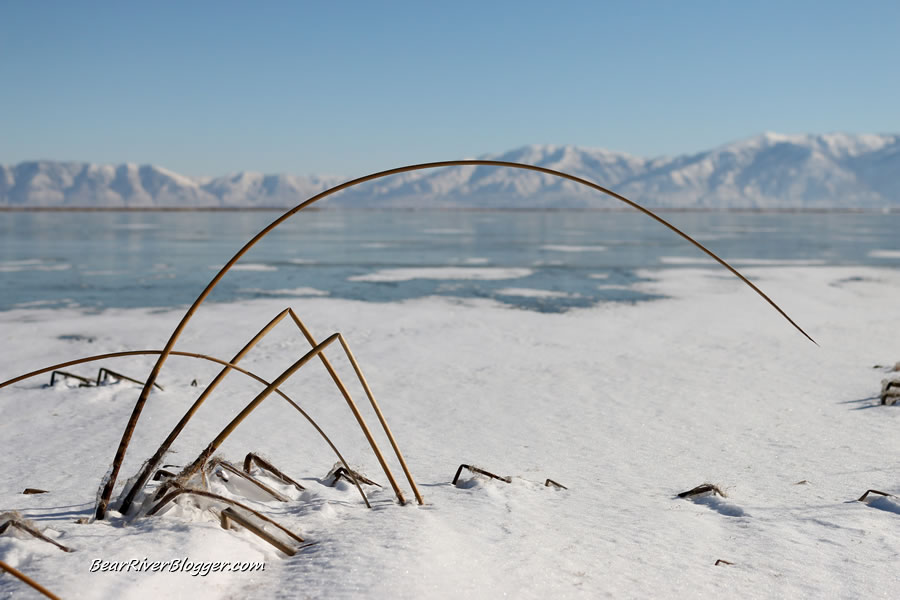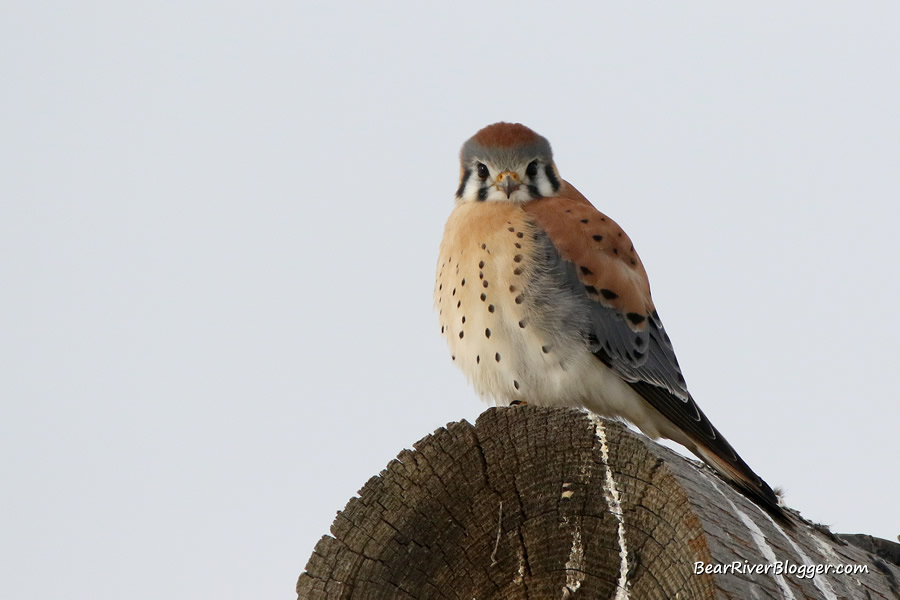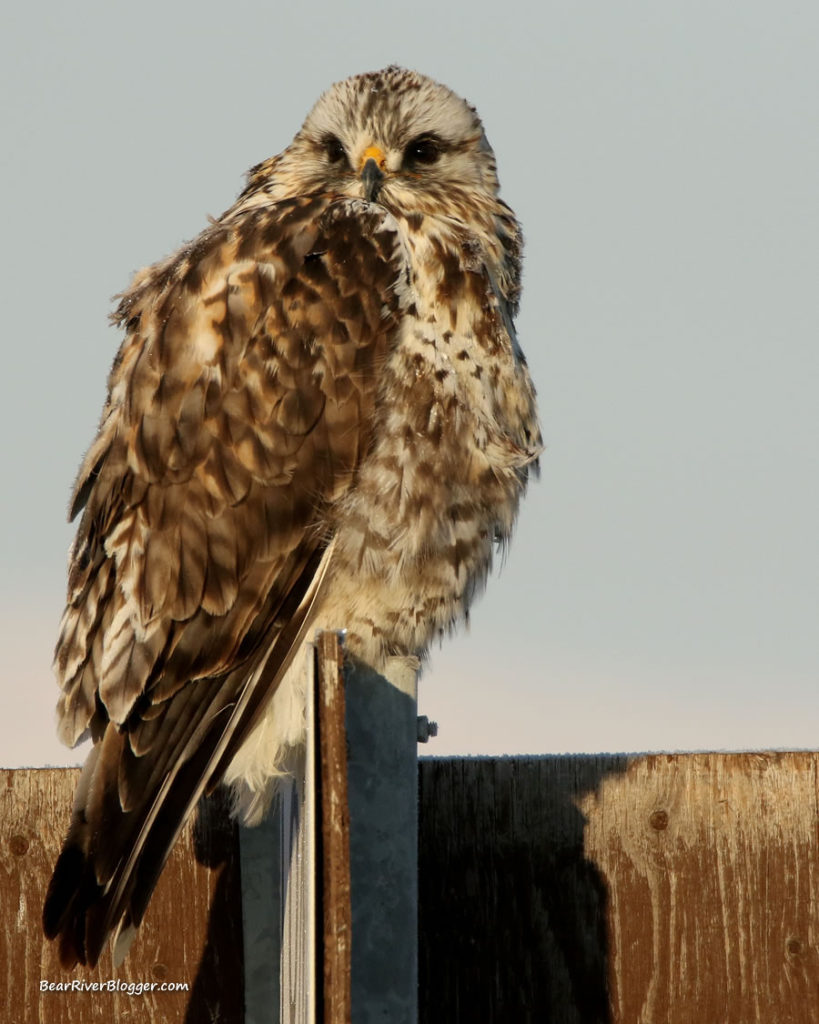Winter on the Bear River Migratory Bird Refuge is often thought of by some people as desolate and barren. I actually do understand the reasoning’s behind this train of thought as there was a period when I spent very little to no time on the refuge during the winter months.
Admittedly, I too thought of it as a frozen, desolate landscape, held captive by the icy grip of ol’ man winter only waiting to be released by the first advances of an impending spring thaw.

But as I spent more time on the refuge during the coldest months of the year, I began to see a part of the refuge I had never seen before. I was able to view the landscape and its inhabitants in a whole new light, one that allowed me to see the interesting things I had missed before, new and intriguing sights, sounds, and experiences I am now able to enjoy and admire as well as to photograph.
Personally, I now find the refuge a mesmerizing place during the winter months, and I frequent it often during the coldest parts of the year to not just experience the peaceful solitude only this time of year can bring but to go and do some serious bird watching and photography as well.
I will admit the numbers of birds that use the refuge during the dreads of winter are way, way down when compared to summer, but that doesn’t mean there isn’t a good birding experience to be had because, well, there is.
Winter is actually the best time of year, and, in some cases, the only time of year, to, in fact, see a few particular species of birds on the Bear River Migratory Bird Refuge. It is also a time when the crowds are almost non-existent, and you can literally have the place to yourself for hours on end.
You will also find once freeze-up has occurred and, as a result, waterfowl hunting season has wound down, the tranquility of the place is almost as compelling as some of the birds you will find on the nearly 77,000-acre wildlife preserve.
Let me give you an example of what I am referring to with regard to a recent trip to the refuge auto tour route from just a couple days ago. It was a very cold and cloudy day but I loved every minute of the 2-hour drive around the frozen marsh.
What should I expect?
First and foremost, I will say you should never go bird watching during winter with any preconceived expectations. Somedays you will find more birds and other days you will see very few, that is just the nature of the beast this time of year.
But even on slow days, I find what interactions with birds I do come across are much more meaningful because I had to work for them, spend time to find them, as it were, and that is the most rewarding part of all.
For me, bird watching isn’t just about the numbers and species of birds I find but rather the overall experience and opportunity to just locate and watch birds out in nature. This is particularly true when it is in a unique setting or situation, which is common during winter, and the bird is doing something not seen during the rest of the year.
It doesn’t matter, for example, if it is a great blue heron, a bird I have seen hundreds of times on the refuge, or a peregrine falcon, a far more uncommon sighting, both birds can and do offer me time away from the hectic modern world we live in to unwind and relax.
Winter oftentimes add to this enjoyment as the wintery antics of birds this time of year can be quite entertaining as well as educational.
Birds found on the refuge during winter
Birds that have been found on the Bear River Migratory Bird Refuge during winter include northern shrike, horned lark, pied-billed grebe, bald eagle, rough-legged hawk, tundra swan, great blue heron, Townsend’s solitaire, song sparrow, white-crowned sparrow, western meadowlark, house finch, northern harrier, barn owl, short-eared owl, and Canada goose.
What is the best time of day for winter bird watching?
I will say, without any reservation, morning is the best time of day to visit the Bear River Migratory Bird Refuge for bird watching, even during the winter. It seems the birds are more eager to behave and act out their part in nature as the sun rises above the Wasatch mountains and hands the refuge over to the dawn of a new day.
This is when most birds are anxiously feeding after a long cold night, which gives the bird watcher an opportunity to view birds being a bit more, well, active.
Later in the afternoon, especially on colder days, I find birds are more apt to sit and not move around as much. Preserving energy is a vital piece of winter survival, and during the coldest parts of winter, many birds will just sit for much of the day to conserve precious energy when temperatures are extremely low.
Rough-legged hawks
I mentioned winter on the Bear River Migratory Bird Refuge brings in a few bird species not seen during the rest of the year, and the rough-legged hawk is one of the most prominent of those winter birds.
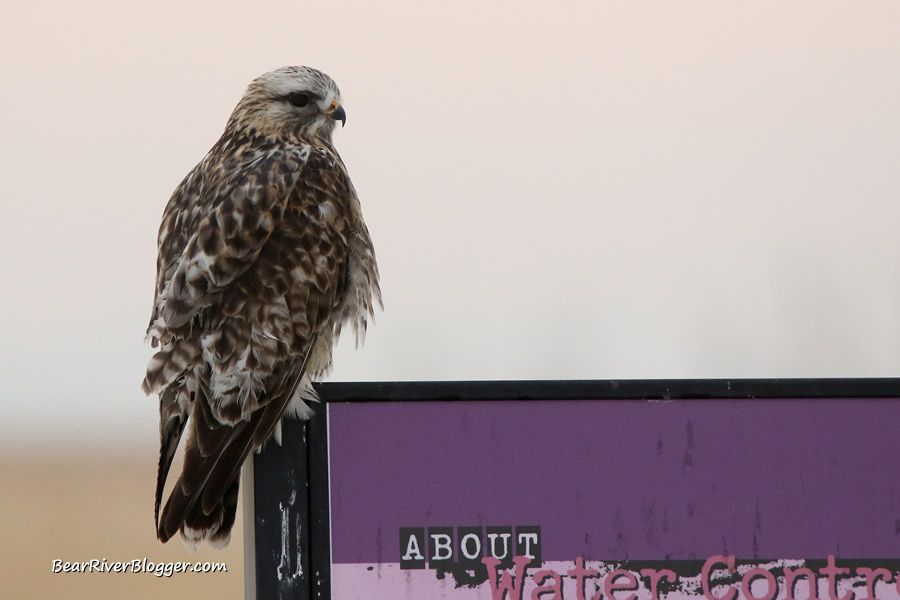
Breeding in the far northern reaches of the arctic tundra, the rough-legged hawk migrates to the lower portion of the United States to spend their winters. We are very fortunate here in Utah that the bird refuge is a wintering ground for these beautiful raptors, which are only seen in this part of the country for a short couple of months or so.
I was shocked to have seen so many rough-legged hawks on this particular trip as I counted over 24 of these raptors on my drive. I don’t keep any formal record of sightings, but this was without question one of the most prolific trips on the auto tour route and quite possibly the most rough-legged hawks I have ever seen on one trip to the refuge.
Seeing these birds by themselves makes the winter birding efforts all worth it by itself.
Bald eagles
Even though Utah does have a few breeding pairs of bald eagles, these magnificent birds are still an uncommon sight in our state for much of the year. Winter, however, is a time bald eagles are commonly seen throughout Northern Utah, and the refuge and surrounding area is certainly no exception.
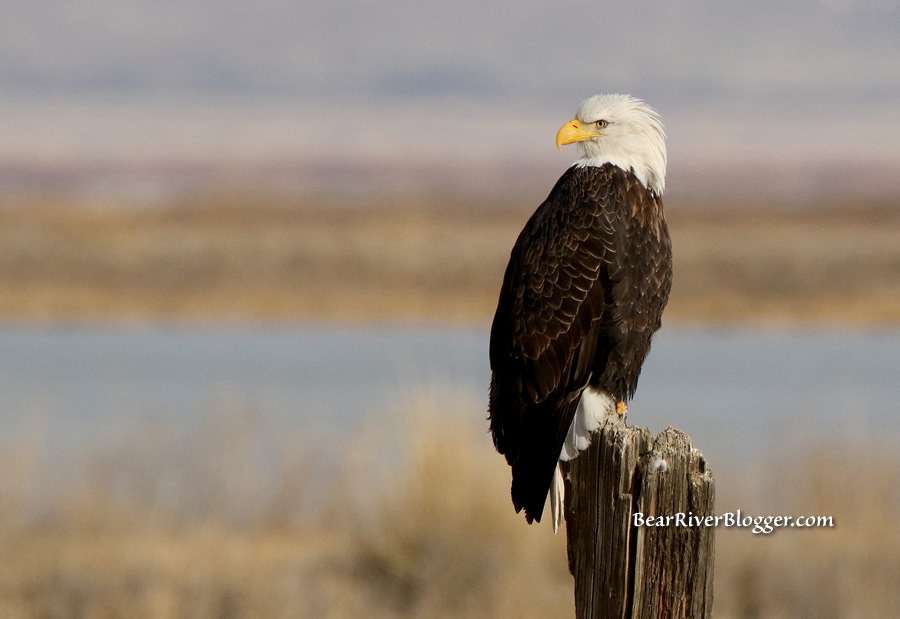
I found a couple bald eagles on this drive but, unfortunately, they were standing too far out on the ice to get a photograph. As winter progresses, sightings of bald eagles on the refuge do become more common, and early February is one of the best times I have found to view the majestic eagle on and around the refuge.
The Bear River Migratory Bird Refuge hosts an annual bald eagle day in February where visitors can come to the refuge education center to see a real-life bald eagle presentation and learn more about eagles and other raptors.
Waterfowl
Some waterfowl species can be found on the Bear River Migratory Bird Refuge during winter, including mallards, Canada goose, tundra swans, gadwall, common goldeneye, bufflehead, lesser scaup, green-winged teal, northern shoveler, and American wigeon.
Small pockets of open water on the canals offer the winter bird watcher opportunities to view and photograph several species of ducks a bit closer than usually presented during the summer months when open water is an unlimited resource and the birds spend their time further away on the large open water impoundments.
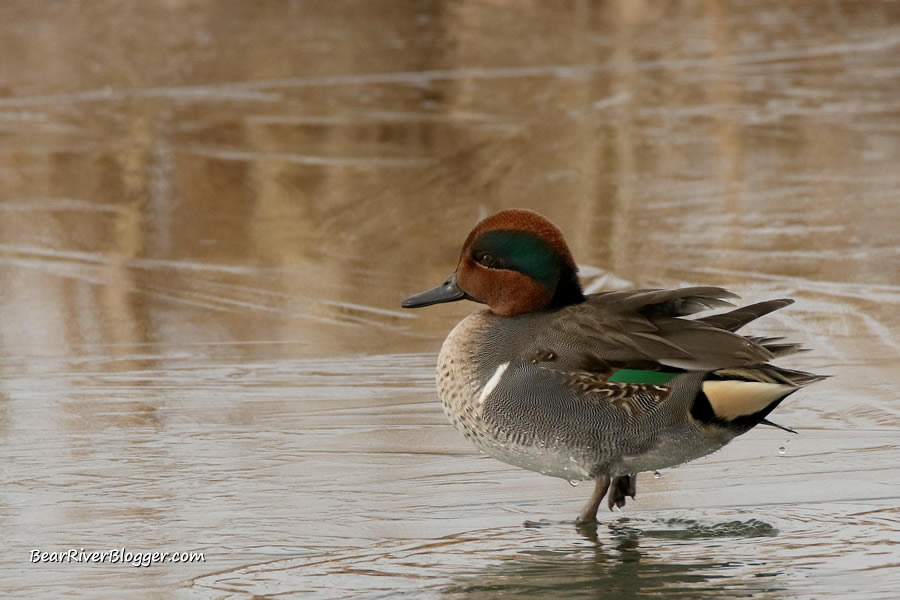
This handsome drake green-winged teal was casually perched on the edge of a patch of ice on a canal running alongside the auto tour loop. A variety of ducks was observed on this trip, including golden-eyes, mergansers, a few mallards, widgeons, and a couple drake pintail ducks.
An interesting find on this trip around the refuge auto tour route was a flock of tundra swans I have been routinely observing during past winters on the refuge. Typically, these arctic breeding birds head for California at first freeze-up, but it is becoming more and more common each year to see small bands of tundra swans spend the winter on the Bear River Bird Refuge.

I think the latest count by other birders and refuge personnel has about 750 tundra swans currently on the refuge. March is when the refuge literally comes alive with the sights and sounds of thousands of migrating swans, but a few are indeed making themselves available a bit earlier for the anxious and dedicated bird watcher willing to get out and spend some time in search of these beautiful birds.
Pied-billed grebes
The winter months wouldn’t be complete if the pied-billed grebe wasn’t added to the list. This curiously shy bird spends time on the refuge during the harshest, coldest parts of the year congregated in small pockets of moving water on canals and waterways.

If you find open water during winter, you usually find pied-billed grebes there as well. I don’t know how or why these small-framed birds spend winters in such cold, harsh environments, but they do. Constantly diving for small fish and to avoid predators, the pied-billed grebe seems to be quite at home in the icy waters of the refuge during winter.
An interesting side note about the pied-billed grebe and how they actually do help the great blue heron survive the winter months will be coming up in a future blog post.
Falcons
Falcons are a very captivating species of bird, but one not often seen on the Bear River Bird Refuge for much of the year. Winter, however, is when I most consistently find falcons on the refuge, and today was one of those days with a prairie falcon sighting on the southern portion of the auto tour route.
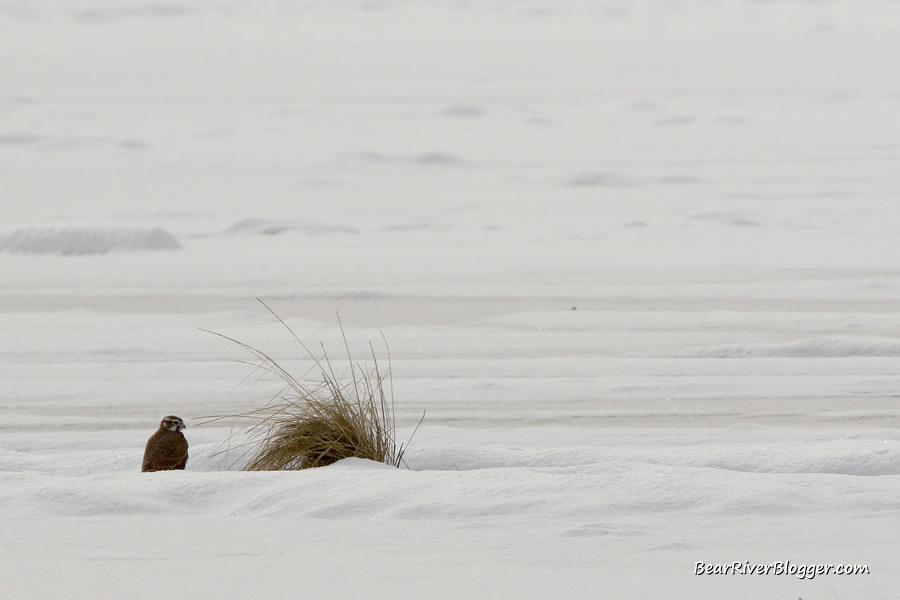
Besides the American kestrel, I find prairie falcons to be the falcon most often found on the refuge. I do occasionally observe peregrine falcons and the rare merlin during winter, but the prairie falcon is fairly common during the winter months if you keep a lookout on both Forest street and the auto tour route.
Great blue herons
I saved my favorite winter bird on the refuge for last, the great blue heron. Even during our extremely cold, brutal winters, the great blue heron doesn’t migrate but searches around the refuge for small pockets of open water to fish over. When the refuge has all but completely frozen over, I see dozens of them move off of the refuge to the Bear River itself to find small pockets of water to hunt from.
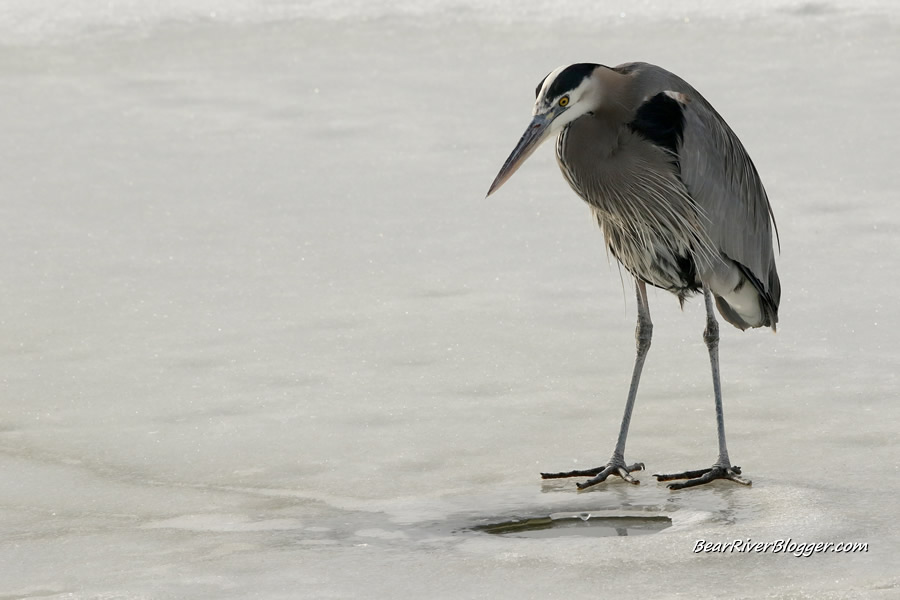
A few winters ago, I was able to observe about 50 great blue herons standing out on an alkaline mudflat for some strange reason. They typically are solitary creatures outside of the breeding season but sometimes during winter, you can find small to moderate-sized groups of great blue herons on the refuge and incoming Bear River.
On this particular trip around the refuge auto loop, I came across a moderate-sized group of herons standing out on the frozen pond. About 20 of the large steel-gray colored birds were scattered all over the ice. Gulls were patiently perched nearby many of these seemingly most patient herons, possibly awaiting an opportunity to scavenge a free meal.

auto tour route
The auto tour route is the gem of the refuge. It is a 12-mile self-guided loop visitors can drive on their own, at their own leisure, and experience the bird refuge up close and personal, the way nature should be experienced.
Winter does cause the gravel road to sometimes be a bit rough with potholes and even snow and ice, but I personally have never had any issues driving the route during winter. Occasionally, the road will be closed due to ice, snow, or unsafe conditions, so it is always advised to check with the refuge headquarters to get up to date conditions and status of the auto tour route.

For more information about the refuge
If you are like me, a lover of nature no matter where it is, feel free to subscribe to my blog. I spend several days a week, year-round, on the refuge and sometimes 5-6 days a week during spring and summer looking for and photographing the unique creatures found on the Bear River Migratory Bird Refuge and surrounding areas.
The images and experiences are all my own. Getting out and experiencing the refuge is the best way to enjoy it, but if you follow my blog, I will show you through my eyes and lens what an amazing and incredible place the refuge truly is if you are unable to visit it first hand.
Birding Apparel
If you’re looking for birding related gifts and apparel for someone, take a look at our online store featuring some of our own photographs turned into unique gifts.

As a reader of our blog, we offer you 20% off all products on our store by using the coupon code save20 during checkout.
Visit our Bird Shirts and More online store to check out our products. New products are constantly being added so check back often.
